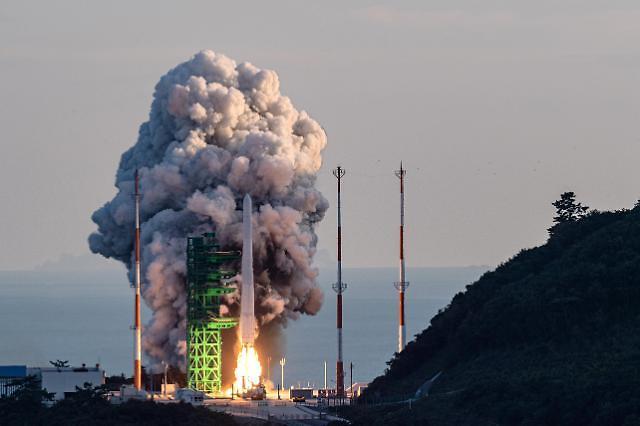
[Yonhap Photo]
South Korea unveiled a 10-year "Space Pioneer" project in 2021 to spend some 211.5 billion won ($174 million) on raising the localization rate of high-tech and core space components for satellites and projectiles to 97 percent or more. Three technologies have been selected in the projectile field -- propellant tanks, integrated avionics, and umbilical connections.
A consortium led by NDT Engineering was selected in June 2021 to develop common bulkhead propellant tanks. Common bulkhead refers to the methodology for placing or packaging the propellant storage tanks within the vehicle, one adjacent to the other with a common interface in between.
For the development of technologies that would commence in 2022, the science ministry announced the selection of two new teams on March 22, including Danam Systems, a defense communication technology company that would lead a research team for integrated avionics, which is designed to reduce weight and cost by integrating existing equipment for the application of small projectiles.
In the avionics field, mission control, combined navigation, communication, engine control, power, telemetry, and flight termination functions will be modularized and integrated to build a low-cost, lightweight projectile.
Hanyang ENG and two other companies will develop umbilicals, a connector that supplies oxidizing agents, fuels, and electricity to launch vehicles. South Korea would develop a single-stage connection technique that does not require a launch tower to reduce costs.
"As the small satellite industry is growing around the world, the importance of developing small projectiles for the smooth launch of 170 public satellites over the next 10 years is increasing," Kwon Hyun-joon, a science ministry official in charge of space, nuclear and big science policy, said in a statement.
"Space Pioneer" is part of South Korea's broad space program which has seen slow progress as other countries are reluctant to transfer core technologies. The Seoul government has vowed to create a self-sustaining industrial ecosystem and cultivate innovative companies like Space X, a U.S. aerospace company.
Space scientists advocate a wise strategy to target niche markets at a time when reusable projectiles that can drastically reduce costs are emerging as a game-changer. South Korea has disclosed the goal of developing small satellites weighing under 100 kilograms that would be carried by a three-stage indigenous rocket called Korea Space Launch Vehicle-2 (KSLV-2) or Nuri.
In June 2021, Economy and Finance Minister Hong Nam-ki proposed the development of more than 100 ultra-small public satellites for defense and telecommunication by 2031. Hanwha Aerospace works with the Korea Aerospace Research Institute (KARI) to push for the early completion of a low-cost, high-efficiency launcher that can shoot a satellite weighing 500 kg into space. KARI is involved in a space program to produce small low-orbit satellites weighing under 100 kg.
Copyright ⓒ Aju Press All rights reserved.



